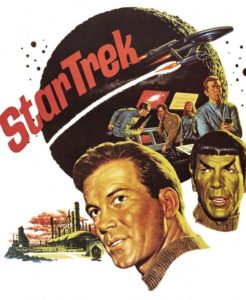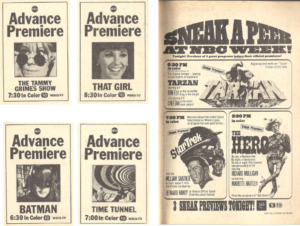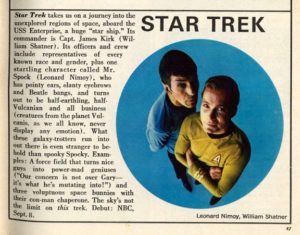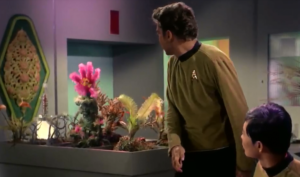
It’s almost the 50th anniversary of the premiere of “Star Trek” on NBC. As a tribute to a show that I have enjoyed since I was a kid (way back in the early 90’s), I plan to watch every episode of the Original Series each week, on their respective airdates. However, I am taking a different approach as we navigate through this exciting time.
I thought recently, “What if I were my current age, never heard of this show, and saw the promos/advertisements for the show, and my curiosity piqued. What would I think after I watched the premiere?”
So, I am going to take the approach of an average viewer and try to give an impression of what an average TV viewer would have thought of this show when it premiered on September 8th, 1966.
At this stage, all I would have to go on are a few rumblings in the press and trade publications about the pilot being picked up to series and who was starring in it. By about this point, when this article is being published (August 26th), mentions of it might have appeared in newspapers. But for certain, I and others would have seen this promo airing either during NBC network programming or during local time:
The artwork seen in the promo was done by James Bama based on promotional photos from the second pilot, “Where No Man Has Gone Before” shot the previous summer. It’s quite good artwork when you look at it, but you can see the obvious misinterpretation of what propels the ship in the photo.

I’ll admit, the NBC promo was very limited, using one the one rendering scanned in different places. But, with the show coming dangerously close to not meeting airdates, it’s the best the promo makers at NBC could have done to tantalize the audience.
You will also notice that NBC was going to premiere Star Trek on September 15th on their annual “NBC Week.” But the program planners at NBC had a trick up their sleeve. They decided to give special “Sneak Previews” of their new fall shows. So the previous week became the “Sneak Preview” week. Star Trek had it’s special Sneak Preview episode on September 8th. ABC apparently got wind of this and decided to copy the stunt and call it “Advance Premieres.”

The actual TV Guide fall preview issue didn’t come out until the week of the Sneak Previews (which would be listings for the following week), so I’m guessing that I wouldn’t have seen that information before the Thursday night premiere. I remember that when we had a TV Guide subscription in my house in the late 90s that we would get the next issue sometime around Wednesday or Thursday. It’s probably likely that the issue was on newsstands by the day of the September 8th premiere.

So based on all of this, would I, assuming the guise of the average TV viewer had been excited? Yes, I would have been. Based on my sensibilities and tastes, even if I had been alive in that era, I can safely say that I would have been enthusiastic about what I was reading about the show and what I had seen in that promo. Looking at what was on against the show on the other two networks…

“The Tammy Grimes Show” was very forgettable. I doubt I would have wanted to watch that show. “My Three Sons” on CBS was a true ratings success, plus the show has a funny concept, so I might have wanted to watch that one as well. Remember kids, there were no VCRs/DVRs/etc. in 1966! At 9:00pm, you could flip over to “Bewitched” on ABC, or the beginning of the “CBS Thursday Night Movie.” Tough choice there, since CBS usually programmed big blockbuster movies in that slot. In the case of the premiere night, CBS showed the 1961 Jerry Lewis comedy “The Ladies Man.”
In hindsight, I can see where the majority of viewers might be turned off by the sight of a Sci-Fi series like “Star Trek.” Imagine the reaction of the average household at that time:
“That show looks too complicated!”
Or…
“That looks like a kiddie show!”
I would bet more on the second of those reactions being what more households who might have seen one of the promos above might have thought. So, they’ll probably stick with the Douglas family, or Sam and Darren, or just turn the TV off and spend time with their family and/or go to bed.
So, that sets the stage for the “Sneak Preview” of Star Trek. The next post will be the day after the premiere, with my thoughts on what I would have thought after I had watched the premiere on September 8th, 1966 on NBC.











